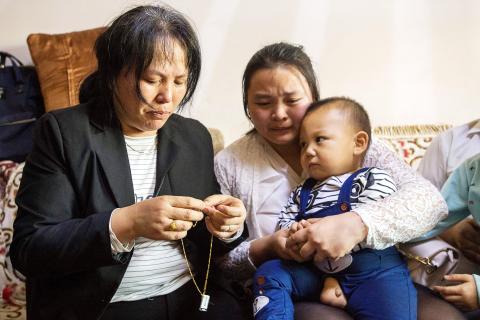A tearful reunion between parents and their missing daughter after an agonizing 24-year search has put a spotlight on the vexed issue of child trafficking and disappearances in China.
Wang Mingqing and his wife Liu Dengying, from southwest Sichuan Province, lost their three-year-old daughter in 1994 when she vanished after being momentarily left alone at the family’s fruit stand.
Earlier this year, a woman living thousands of kilometers away in Jilin Province contacted Wang after spotting a sketch of what his daughter may look like today along with the family’s story on the Internet.

Photo: AFP
照片:法新社
Results of a DNA test confirmed that the woman, Kang Ying, is Wang’s lost daughter and on Tuesday the family had an emotional reunion in the city of Chengdu.
Unaware of her origins, Kang said she had lived as a child with her adopted parents, less than 20km from Wang’s home in the same county.
There are no official statistics on the number of children who go missing in China every year. The exact circumstances of Kang’s disappearance remain unknown.

Photo: AFP
照片:法新社
A missing persons alert system launched by the Ministry of Public Security in May 2016 has broadcast information about 2,767 missing children and managed to find nearly 2,700 of them as of March 15, data from the ministry showed.
But many more are believed to be abducted each year and sold to underground adoption agencies. In the past, China’s one-child policy — which expanded to two in 2015 — and a preference for sons fueled the trafficking of children.
“To reduce the red-tape and time required to go through the formal adoption process, an underground network of kidnapping gangs emerged to accommodate those who are willing to pay more,” Matt Friedman, a former UN regional manager of anti-trafficking in Asia, told AFP.
“Most couples who adopted from these networks didn’t know that the infants they brought home were stolen from hospitals or communities,” Friedman said.
China is building a national DNA database with blood or saliva samples and iris scans collected from random citizens and groups.
According to the public security ministry, one of the main aims of the database is to help people find their lost parents or children.
But the international non-governmental organization Human Rights Watch has criticized the project, saying it lacked “oversight, transparency, or privacy protections.”
(AFP)
經過二十四年焦灼的搜尋,一對夫婦終於與失蹤的女兒團圓,潰堤的淚水讓大眾開始關切中國令人憂心的兒童販賣問題以及失蹤兒童案件。
在一九九四年,來自中國西南方四川省的王明清與妻子劉登英,只是暫時把年僅三歲的女兒獨自留在家裡開設的水果攤上,她卻從此失去蹤影。
今年年初,在數千公里之外的吉林省,有一位女士在網路上偶然看到一幅素描畫像,描繪著王明清失蹤女兒今日可能的容貌,也一併讀到這個家庭的故事,遂連絡了王先生。
經過DNA鑑定,證實這位住在吉林省的康英女士就是王明清當年失蹤的女兒,一家人本週二在成都市激動地團圓。
多年來,康女士從未注意過自己的出身來歷,她說自己從孩提時代開始就和養父母一起住,養父母的住處跟王家位於同一個縣,相距不到二十公里。
目前並沒有官方數據統計中國每年失蹤的兒童人數。康女士當年失蹤的確切情況至今仍無人知悉。
在二○一六年五月,中國公安部啟動一項失蹤人口通報機制,向外界發布兩千七百六十七名失蹤兒童的相關資料。公安部的數據顯示,截至今年三月十五日,名單中將近兩千七百名兒童已被尋獲。
然而,據信每年仍有更多兒童遭到誘拐,再被賣給仲介兒童領養的地下公司。中國過去的「一胎化」政策──在二○一五年已將限制放寬為二胎──以及重男輕女的偏好,助長了販賣兒童的情況。
前聯合國亞洲地區打擊人口販賣專案計畫的專員麥特‧弗里曼向法新社表示:「為了簡化正式領養兒童過程中的繁文縟節、縮短流程所需時間,由綁架集團組成的地下交易網絡遂應運而生,為那些願意付更多錢領養小孩的父母大開方便之門。」
弗里曼說:「透過地下網絡領養小孩的夫妻,絕大多數並不知道他們帶回家的嬰兒其實是從醫院或鄉間偷來的。」
中國正在建制一個國家級的DNA資料庫,隨機抽樣人民和團體,採集他們的血液與唾液樣本,並且進行虹膜掃描。
根據公安部的說法,設立這個資料庫的主要目的之一,是要幫助人們找到失散的父母或孩子。
然而,國際非政府組織「人權觀察」大力抨擊中國政府的這個計畫,認為計畫的執行缺乏「監督、透明度,或是隱私權保障。」
(台北時報章厚明譯)

Rice is essential to Japanese culture, tradition and politics. People take pride in the oval-shaped sticky Japonica grain, which is still a staple even though total consumption has fallen over the decades. But since last summer, prices have soared as supplies have fallen short of demand. The government has long paid farmers to cut back on rice acreage, and change to other crops to keep rice prices relatively high. To cope with shortfalls this year, the government has released rice reserves. But the grain has been slow to reach supermarket shelves. Anger over that was part of the reason the Agriculture Minister

In Taiwan, 7-Eleven convenience stores can be found on almost every street corner. With over 84,600 stores across 20 countries, 7-Eleven has more locations than any other retail business on Earth. For millions of people, the chain is an important part of daily life, providing coffee, quick meals, and essential items for those __1__. The history of 7-Eleven began nearly 100 years ago in Dallas, Texas. In 1927, the Southland Ice Company began selling blocks of ice that were used to keep fridges cool. Shortly after opening, the company __2__ its offerings to include groceries like milk, eggs, and

Step into any corner of Turkiye, and you’ll likely encounter the iconic “Evil Eye,” known as “nazar boncu?u” in Turkish. This striking blue glass ornament is shaped like an eye with concentric circles of dark blue, white, and light blue. While its name in English suggests something threatening, it’s actually a charm designed to ward off misfortune. The origins of the nazar boncu?u can be traced back to ancient Mediterranean and Middle Eastern traditions. The word nazar comes from Arabic, meaning “gaze,” while boncu?u translates to “bead” in Turkish. Central to the nazar boncu?u’s mythology is the idea that

Continued from yesterday(延續自昨日) https://www.taipeitimes.com/News/lang In 1946, the company adopted the name 7-Eleven to reflect its newly extended __3__, from 7am to 11pm, a novel concept at the time. As a rapidly growing company, it began offering franchise opportunities in the 1960s. In 1974, the first 7-Eleven in Japan was opened by the supermarket company Ito-Yokado. The Japanese franchises were __4__ successful that by 1991, Ito-Yokado was able to acquire a 70 percent stake in Southland Corporation. Its investments eventually resulted in full ownership of 7-Eleven, which paved the way for the Japanese company to enter the international market. Since then, 7-Eleven